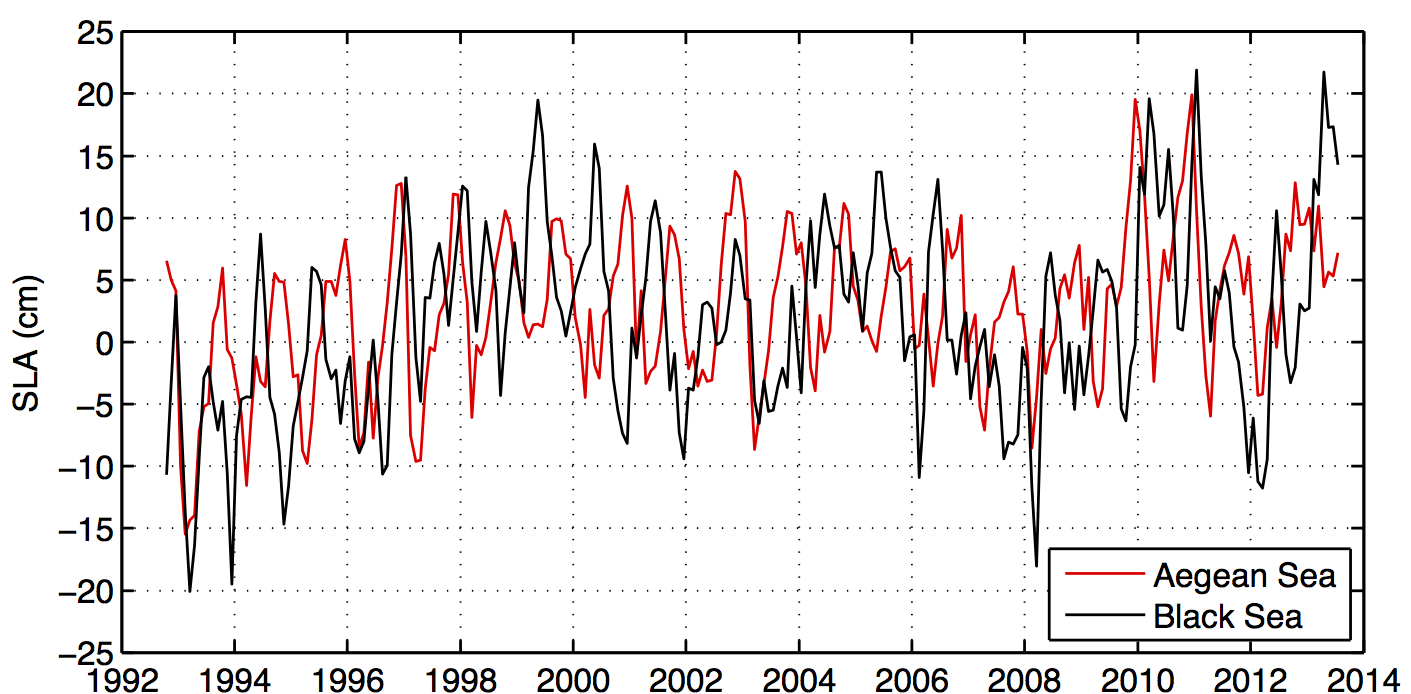Abstract's details
On the internal and external forcing of sea level variability in the Black Sea
Event: 2014 Ocean Surface Topography Science Team Meeting
Session: Science Results from Satellite Altimetry: Regional and basin-scale processes and sea level rise
Presentation type: Poster
Basin-averaged sea level variations in the Black Sea are a function of the basin's freshwater budget, the exchange through the Strait of Bosphorus, and depth-integrated changes in the seawater temperature and salinity. Compared to the mass-related sea level changes, the mostly seasonal steric effects are rather small. On average, the excess of precipitation (P ~ 300 km3 yr-1) and river runoff (R ~ 350 km3 yr-1) over evaporation (E ~ 350 km3 yr-1) is balanced by the net outflow (Qnet ~ 300 km3 yr-1) through the Strait of Bosphorus. The Bosphorus response to fresh water leakage from the Black Sea, the along-strait pressure gradient, and local wind forcing is frequency dependent and strongly nonlinear.
In this research we update previous studies of sea level variability in the Black Sea to the near-present time using a combination of satellite altimetry and gravity (GRACE) measurements, in combination with tide gauge, river discharge, and atmospheric re-analysis data. Over the period of satellite altimetry observations in the Black Sea from 1992 to present, sea level exhibited very large record-high anomalies in March 2010, January 2011, and April 2013. A particular focus of our study is to understand what processes caused these large anomalies.
We present a detailed analysis of the sea level budget components and their relative contribution to sea level variability. Satellite altimetry and GRACE data indicate that the nonseasonal variability of sea level in the Black Sea is linked to water storage over the Black Sea drainage basin. We show that sea level in the Black Sea is correlated with sea level in the Aegean and in the Mediterranean seas, lagging behind by about 1 month. This indicates that external forcing influences the sea level gradient between the two seas, and therefore, by modulation of the Black Sea outflow, affects its sea level. Our results illustrate that an increase/decrease of sea level in the Black Sea follows a decrease/increase of sea level pressure over the southeastern Europe with an amplified decrease/increase over the Balkans, which is associated with northward/southward wind anomalies over the Aegean and Black seas. The anomalies of the meridional wind over the Aegean and Marmara seas can either block or intensify the Black Sea outflow into the Aegean Sea. With a positive fresh water balance in the Black Sea this leads to an increase or decrease of sea level in the latter.
Figure 1. The time series of the nonseasonal sea level averaged over 23°E-27°E and 38.5°N-41°N in the Aegean Sea (red curve) and over the Black Sea (black curve).

In this research we update previous studies of sea level variability in the Black Sea to the near-present time using a combination of satellite altimetry and gravity (GRACE) measurements, in combination with tide gauge, river discharge, and atmospheric re-analysis data. Over the period of satellite altimetry observations in the Black Sea from 1992 to present, sea level exhibited very large record-high anomalies in March 2010, January 2011, and April 2013. A particular focus of our study is to understand what processes caused these large anomalies.
We present a detailed analysis of the sea level budget components and their relative contribution to sea level variability. Satellite altimetry and GRACE data indicate that the nonseasonal variability of sea level in the Black Sea is linked to water storage over the Black Sea drainage basin. We show that sea level in the Black Sea is correlated with sea level in the Aegean and in the Mediterranean seas, lagging behind by about 1 month. This indicates that external forcing influences the sea level gradient between the two seas, and therefore, by modulation of the Black Sea outflow, affects its sea level. Our results illustrate that an increase/decrease of sea level in the Black Sea follows a decrease/increase of sea level pressure over the southeastern Europe with an amplified decrease/increase over the Balkans, which is associated with northward/southward wind anomalies over the Aegean and Black seas. The anomalies of the meridional wind over the Aegean and Marmara seas can either block or intensify the Black Sea outflow into the Aegean Sea. With a positive fresh water balance in the Black Sea this leads to an increase or decrease of sea level in the latter.
Figure 1. The time series of the nonseasonal sea level averaged over 23°E-27°E and 38.5°N-41°N in the Aegean Sea (red curve) and over the Black Sea (black curve).
Contribution: VolkovLanderer_Medi_BS.2014.pdf (pdf, 5597 ko)
Back to the list of abstract